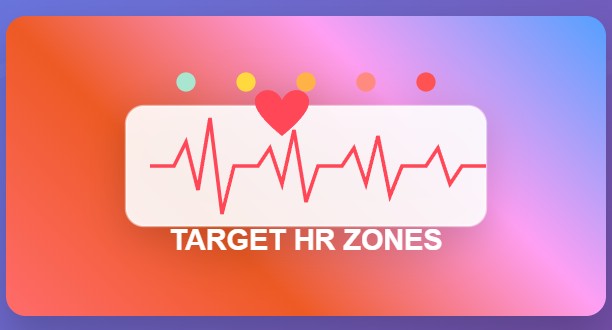Target Heart Rate Calculator
Calculate your optimal heart rate zones for maximum workout efficiency and safety
Heart Rate Calculator
Your Heart Rate Zones
Enter your details and click “Calculate My Zones” to see your personalized heart rate training zones.
Understanding Heart Rate Training
💓 What is Target Heart Rate?
Your target heart rate is the ideal range your heart should beat during exercise to maximize benefits while staying safe. It’s typically 50-85% of your maximum heart rate, varying based on your fitness goals and current condition.
Key Benefits:
- Optimizes workout efficiency
- Prevents overexertion
- Tracks fitness progress
- Ensures safe exercise intensity
🎯 The 5 Heart Rate Zones
Zone 1 (50-60%): Active Recovery – Light activity, promotes recovery
Zone 2 (60-70%): Base Training – Builds aerobic base, fat burning
Zone 3 (70-80%): Aerobic Training – Improves cardiovascular fitness
Zone 4 (80-90%): Threshold Training – Increases lactate threshold
Zone 5 (90-100%): Neuromuscular Power – Maximum effort, anaerobic
📊 How to Measure Heart Rate
Manual Method: Place two fingers on your wrist or neck, count beats for 15 seconds, multiply by 4.
Heart Rate Monitors: Chest straps provide most accurate readings during exercise.
Fitness Trackers: Convenient wrist-based monitors, good for general tracking.
Smartphone Apps: Use camera and flash to detect pulse, less accurate during exercise.
⚡ Factors Affecting Heart Rate
Several factors can influence your heart rate during exercise:
- Age: Max HR decreases with age
- Fitness Level: Fitter individuals have lower resting HR
- Temperature: Heat increases heart rate
- Hydration: Dehydration elevates HR
- Medications: Some drugs affect heart rate
- Stress: Emotional stress can increase HR
Heart Rate Training Tips
🏃 For Beginners
- Start in Zone 1-2 (50-70% max HR)
- Focus on building aerobic base
- Gradually increase intensity over weeks
- Listen to your body, not just numbers
- Allow adequate recovery between sessions
- Aim for 150 minutes moderate activity weekly
🔥 Fat Burning Zone
- Zone 2 (60-70%) is optimal for fat burning
- Body uses fat as primary fuel source
- Sustainable for longer durations
- Improves metabolic efficiency
- Great for weight management goals
- Can be maintained during conversation
💪 Performance Training
- Zone 3-4 (70-90%) for fitness improvements
- Increases VO2 max and endurance
- Improves lactate threshold
- Requires proper recovery planning
- Monitor for signs of overtraining
- Periodize training for best results
⚠️ Safety Guidelines
- Consult doctor before starting new program
- Stop if you feel chest pain or dizziness
- Stay hydrated during exercise
- Warm up before and cool down after
- Don’t exceed 85% max HR without supervision
- Monitor how you feel, not just numbers
Frequently Asked Questions
The Tanaka formula (208 – 0.7 × age) is currently considered the most accurate for general populations. However, the gold standard is a medically supervised stress test. The traditional “220 – age” formula is less accurate but still widely used. Individual variation can be significant, so these are estimates.
For general fitness: 80% of training in Zones 1-2 (easy pace), 20% in Zones 3-5 (moderate to hard). Beginners should focus primarily on Zones 1-2. Advanced athletes may spend more time in higher zones but still maintain the 80/20 principle for optimal adaptation and recovery.
Yes, heart rate naturally fluctuates due to factors like hydration, temperature, fatigue, and cardiac drift (gradual HR increase during prolonged exercise). Small variations (5-10 bpm) are normal. Large sudden changes may indicate overexertion or other issues.
This could indicate good cardiovascular fitness, medication effects, or need for higher intensity exercise. Gradually increase workout intensity, try different activities (running vs. cycling), or consult a fitness professional. Some people naturally have lower maximum heart rates.
Heart rate zones remain the same, but you may reach different zones more easily with certain exercises. Running typically produces higher heart rates than cycling at the same perceived effort. Swimming often shows 10-15 bpm lower due to horizontal position and water pressure.
Initial improvements can be seen in 2-4 weeks with consistent training. Resting heart rate may decrease by 5-10 bpm within a month. Significant cardiovascular adaptations typically occur over 8-12 weeks. Recovery heart rate (how quickly HR drops after exercise) improves relatively quickly and is a good fitness indicator.


